from ESPN http://ift.tt/1dPqUAn
Perseid Meteors over Turkey
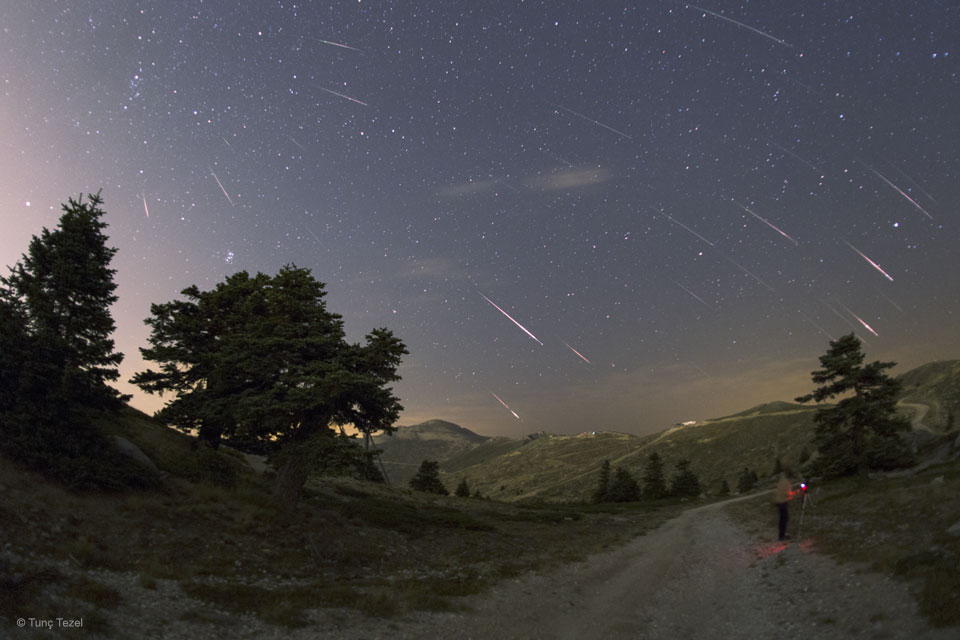
The Perseid Meteor Shower, usually the best meteor shower of the year, will peak late next week. A person watching a clear sky from a dark location might see a bright meteor every minute. These meteors are actually specks of rock that have broken off Comet Swift-Tuttle and continued to orbit the Sun until they vaporize in Earth's atmosphere. The featured composite image shows a outburst of Perseids as they appeared over Turkey during last year's meteor shower. Enough meteors were captured to trace the shower's radiant back to the constellation of Perseus on the far left. The tail-end of the Perseids will still be going during the total solar eclipse on August 21, creating a rare opportunity for some lucky astrophotographers to image a Perseid meteor during the day. via NASA http://ift.tt/2hgcaXB
Sunrise Through the Solar Arrays

On July 26, 2017, a member of the Expedition 52 crew aboard the International Space Station took this photograph of one of the 16 sunrises they experience every day, as the orbiting laboratory travels around Earth. One of the solar panels that provides power to the station is seen in the upper left. via NASA http://ift.tt/2vYsCPc
F/11: Dodgers 3 Giants 2. WP: LAD P Baez (3-1) LP: SF A Suarez (0-1) (ESPN)
from ESPN http://ift.tt/1dPqUAn
Aurora Slathers up the Sky
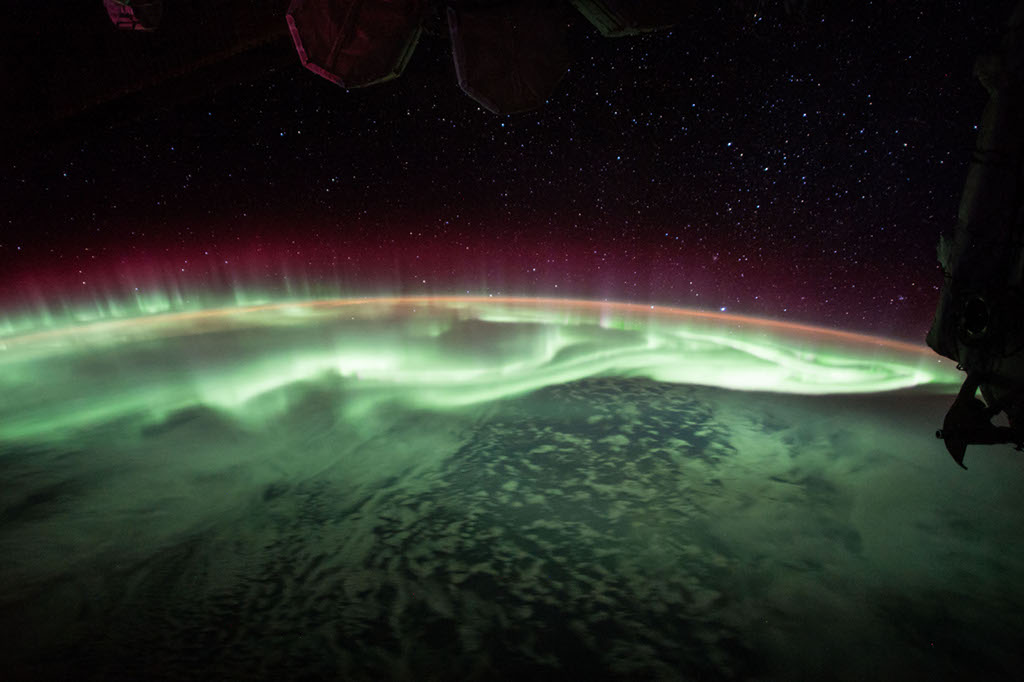
Like salsa verde on your favorite burrito, a green aurora slathers up the sky in this June 25 snapshot from the International Space Station. About 400 kilometers (250 miles) above Earth, the orbiting station is itself within the upper realm of the auroral displays. Aurorae have the signature colors of excited molecules and atoms at the low densities found at extreme altitudes. Emission from atomic oxygen dominates this view. The tantalizing glow is green at lower altitudes, but rarer reddish bands extend above the space station's horizon. The orbital scene was captured while passing over a point south and east of Australia, with stars above the horizon at the right belonging to the constellation Canis Major, Orion's big dog. Sirius, alpha star of Canis Major, is the brightest star near the Earth's limb. via NASA http://ift.tt/2eSjeJ1
Expedition 52 Soyuz Launches to the Space Station

The Soyuz MS-05 rocket is launched with Expedition 52 flight engineer Sergei Ryazanskiy of Roscosmos, flight engineer Randy Bresnik of NASA, and flight engineer Paolo Nespoli of ESA (European Space Agency), Friday, July 28, 2017 at the Baikonur Cosmodrome in Kazakhstan. via NASA http://ift.tt/2tKAz9d
Noodle Mosaic of Saturn
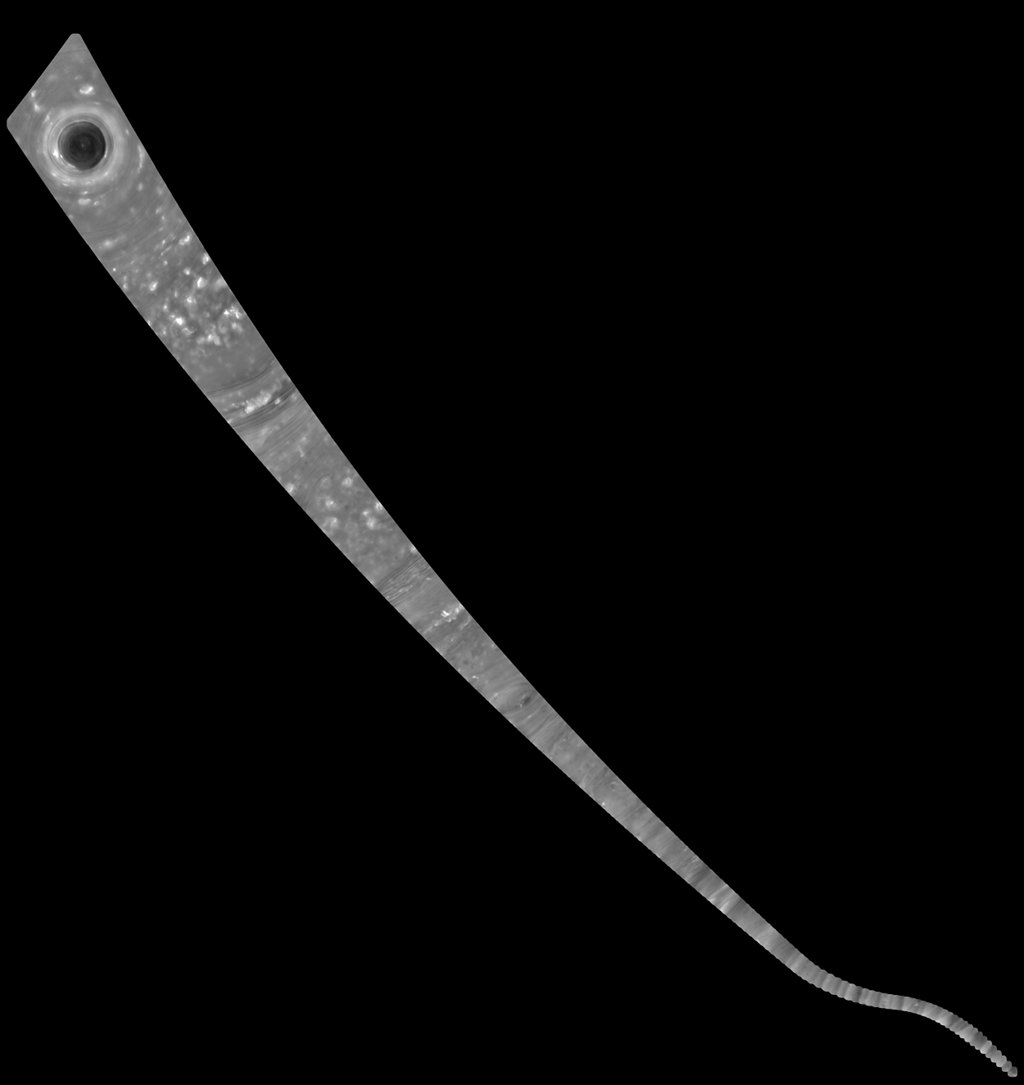
On April 26 the Cassini spacecraft swooped toward Saturn on the first of its Grand Finale dives between Saturn and rings. In this long, thin, noodle mosaic, a rapid series of 137 low resolution images captured by Cassini's wide-angle camera track its progress across the gas giant's swirling cloud tops. The mosaic projection maps the arc along Saturn's atmospheric curve on to a flat image plane. At top, the first mosaic panel is centered at 90 degrees north, about 72,400 kilometers above Saturn's dark north polar vortex. As the mosaic progresses it narrows, the pixel scale shrinking from 8.7 kilometers to 1 kilometer per pixel. For the last panel, the spacecraft is 8,374 kilometers above a region 18 degrees north of Saturn's equator. Frame orientation changes near the bottom as Cassini rotates to maneuver its large, dish-shaped, high-gain antenna forward, providing a shield before crossing Saturn's ring plane. via NASA http://ift.tt/2tL8zqm
Haze on the Horizon

This false-color view from NASA's Cassini spacecraft gazes toward the rings beyond Saturn's sunlit horizon. via NASA http://ift.tt/2uFPXVE
Final: Giants 2 Pirates 1. WP: SF J Samardzija (5-11) LP: PIT T Watson (5-3) (ESPN)
from ESPN http://ift.tt/1dPqUAn
Expedition 52 Soyuz Rollout

The Soyuz MS-05 spacecraft is seen as it is raised into a vertical position on the launch pad at the Baikonur Cosmodrome, Kazakhstan, Wednesday, July 26, 2017. The Expedition 52 crew is scheduled to launch to the International Space Station aboard the Soyuz on Friday, July 28, at 11:41 a.m. EDT (9:41 p.m. Baikonur time). via NASA http://ift.tt/2vIFr0f
Final: Giants 11 Pirates 3. WP: SF M Bumgarner (1-4) LP: PIT J Taillon (6-4) (ESPN)
from ESPN http://ift.tt/1dPqUAn
Red Sox acquire 3B Eduardo Nunez from Giants - multiple reports (ESPN)
from ESPN http://ift.tt/1dPqUAn
Watching the Aurora From Orbit

Expedition 52 Flight Engineer Jack Fischer of NASA shared photos and time-lapse video of a glowing green aurora seen from his vantage point 250 miles up, aboard the International Space Station. This aurora photo was taken on June 26, 2017. via NASA http://ift.tt/2uU3SKy
Final: Pirates 10 Giants 3. WP: PIT G Cole (8-7) LP: SF M Cain (3-9) (ESPN)
from ESPN http://ift.tt/1dPqUAn
Int Ball Drone Activated on the Space Station
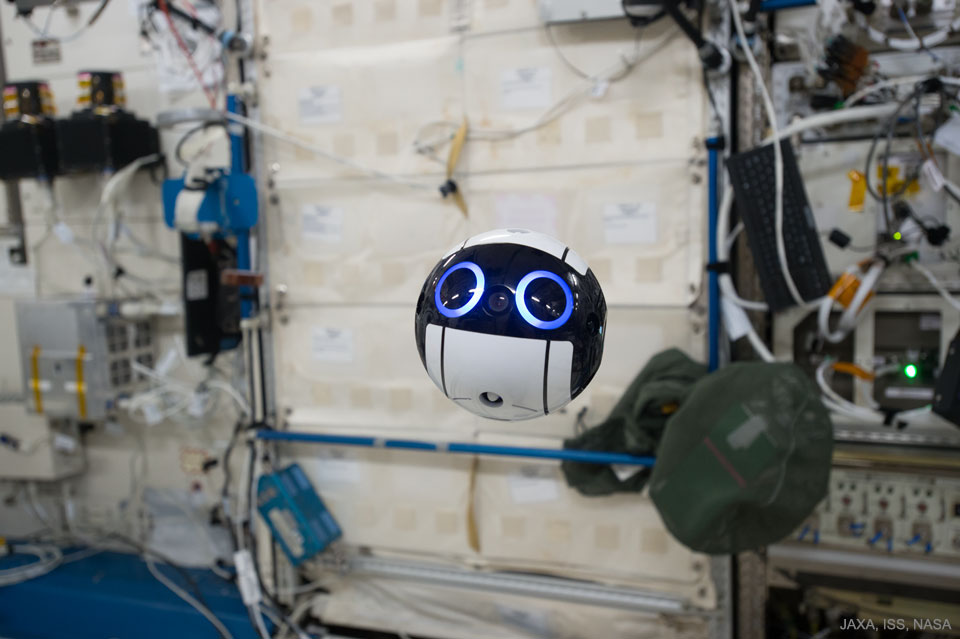
What if you were followed around by a cute floating ball that kept taking your picture? Then you might be an astronaut on today's International Space Station (ISS). Designed by the Japan Aerospace Exploration Agency (JAXA), the JEM Internal Ball Camera -- informally "Int-Ball" -- is a bit larger than a softball, can float and maneuver by itself but also be controlled remotely, can take high resolution images and videos, and is not related to Hello Kitty. Int-Ball was delivered to the ISS in early June and is designed to allow ground-control to increase the monitoring of ISS equipment and activities while decreasing time demands on human astronauts. Int-Ball moves by turning on small internal fans and sees with a camera located between its two dark eyes. via NASA http://ift.tt/2urdlX8
Hubble’s Hunting Dog Galaxy

Tucked away in the small northern constellation of Canes Venatici (The Hunting Dogs) is the galaxy NGC 4242. via NASA http://ift.tt/2twOBzs
A Hybrid Solar Eclipse over Kenya
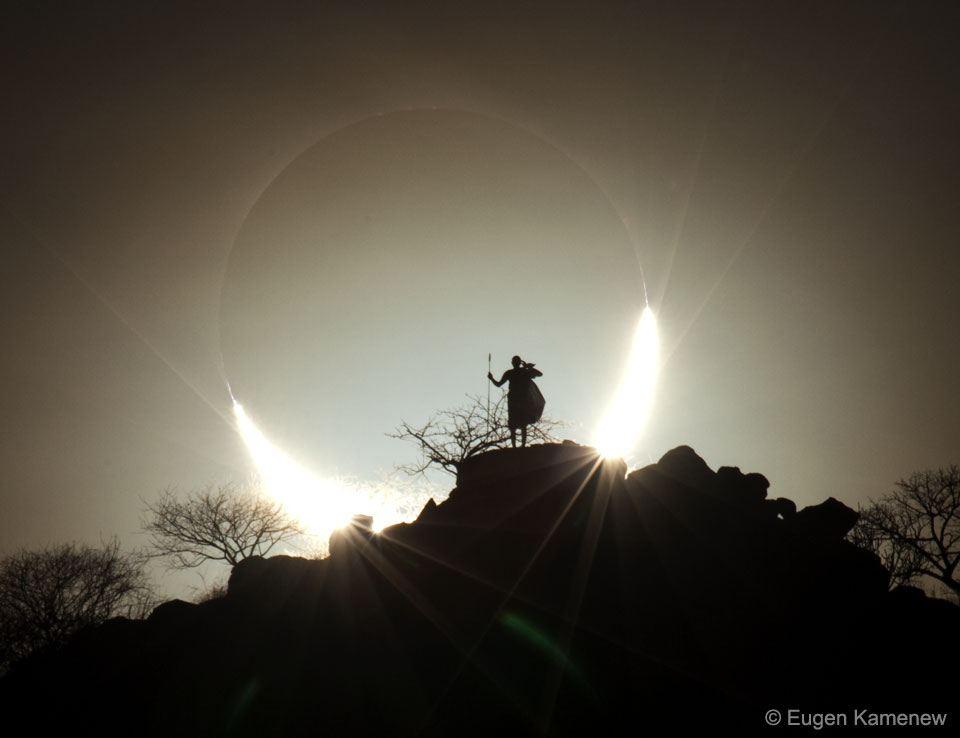
Chasing solar eclipses can cause you to go to the most interesting places and meet the most interesting people. Almost. For example, chasing this eclipse brought this astrophotographer to Kenya in 2013. His contact, a member of the Maasai people, was to pick him up at the airport, show him part of southern Kenya, and even agreed to pose in traditional warrior garb on a hill as the hopefully spectacular eclipse set far in background. Unfortunately, this contact person died unexpectedly a week before the astrophotographer's arrival, and so he never got to participate in the shoot, nor know that the resulting image went on to win an international award for astrophotography. Pictured in 2013 from Kenya, the Moon covers much of the Sun during a hybrid eclipse, a rare type of solar eclipse that appears as total from some Earth locations, but annular in others. During the annular part of the eclipse, the Moon was too far from the Earth to block the entire Sun. Next month a total solar eclipse will cross the USA. via NASA http://ift.tt/2tQTQVG
Mercury as Revealed by MESSENGER
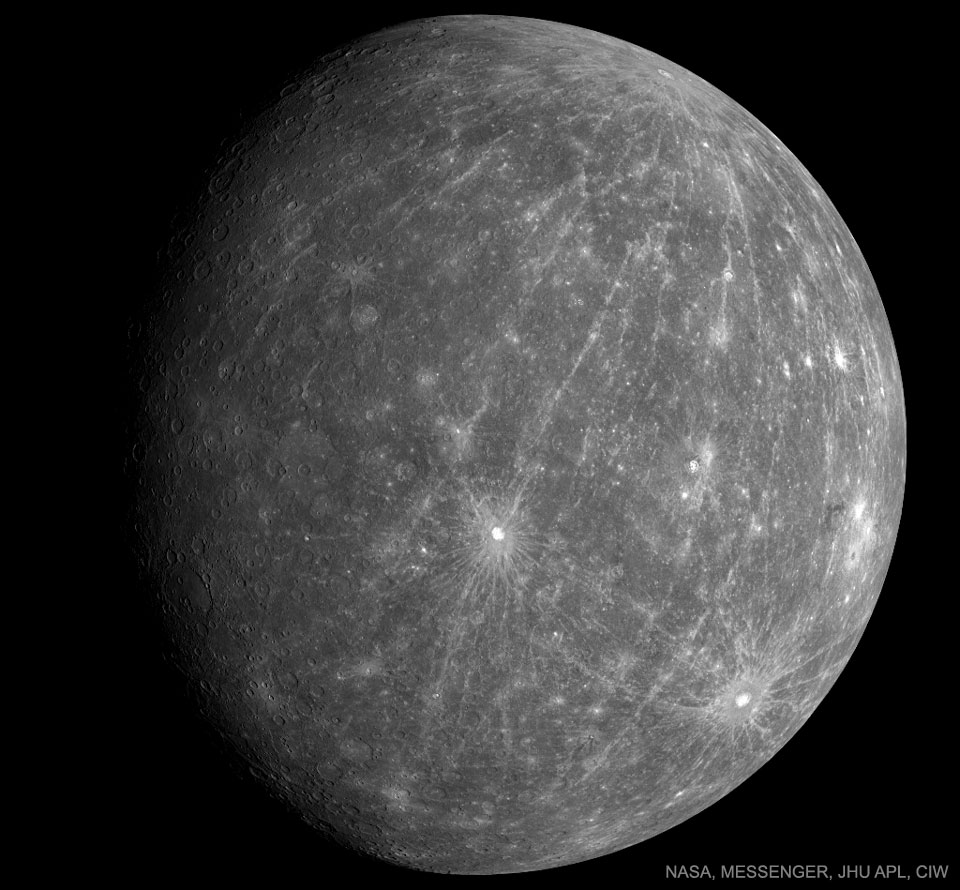
Mercury had never been seen like this before. In 2008, the robotic MESSENGER spacecraft buzzed past Mercury for the second time and imaged terrain mapped previously only by comparatively crude radar. The featured image was recorded as MESSENGER looked back 90 minutes after passing, from an altitude of about 27,000 kilometers. Visible in the image, among many other newly imaged features, are unusually long rays that appear to run like meridians of longitude out from a young crater near the northern limb. MESSENGER entered orbit around Mercury in 2011 and finished its primary mission in 2012, but took detailed measurements until 2015, at which time it ran out of fuel and so was instructed to impact Mercury's surface. via NASA http://ift.tt/2vKLEaX
F/12: Giants 5 Padres 4. WP: SF J Osich (3-1) LP: SD K Quackenbush (0-2) (ESPN)
from ESPN http://ift.tt/1dPqUAn
Apollo 11: Catching Some Sun
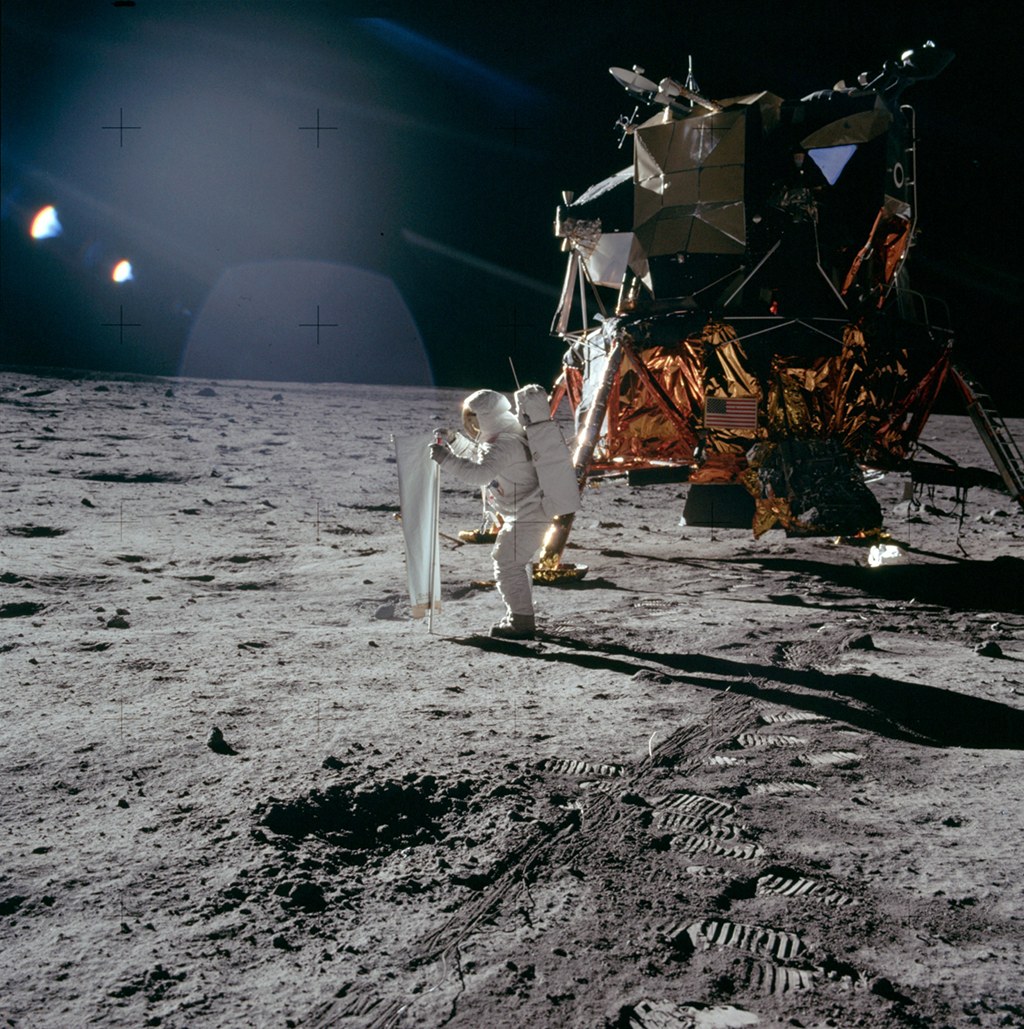
Bright sunlight glints and long dark shadows mark this image of the lunar surface. It was taken July 20, 1969 by Apollo 11 astronaut Neil Armstrong, the first to walk on the Moon. Pictured is the mission's lunar module, the Eagle, and spacesuited lunar module pilot Buzz Aldrin unfurling a long sheet of foil also known as the Solar Wind Composition Experiment. Exposed facing the Sun, the foil trapped particles streaming outward in the solar wind, catching a sample of material from the Sun itself. Along with moon rocks and lunar soil samples, the solar wind collector was returned for analysis in earthbound laboratories. via NASA http://ift.tt/2uOGdeW
Enhanced Color Panorama Above 'Perseverance Valley' on Mars

Toward the right side of this enhanced-color scene is a broad notch in the crest of the western rim of Endeavour Crater on Mars. Wheel tracks in that area were left by NASA's Mars Exploration Rover Opportunity as it observed "Perseverance Valley" from above in the spring of 2017. via NASA http://ift.tt/2uhwo7D
Phobos: Moon over Mars
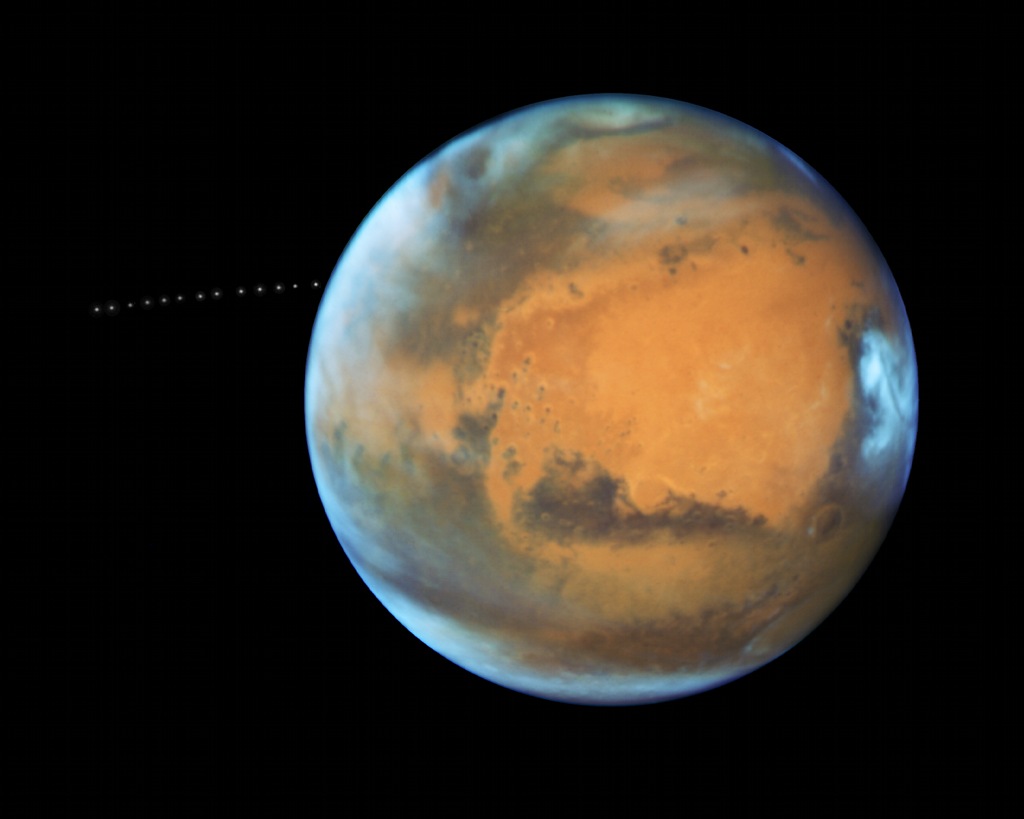
A tiny moon with a scary name, Phobos emerges from behind the Red Planet in this timelapse sequence from the Earth-orbiting Hubble Space Telescope. Over 22 minutes the 13 separate exposures were captured near the 2016 closest approach of Mars to planet Earth. Martians have to look to the west to watch Phobos rise, though. The small moon is closer to its parent planet than any other moon in the Solar System, about 3,700 miles (6,000 kilometers) above the Martian surface. It completes one orbit in just 7 hours and 39 minutes. That's faster than a Mars rotation, which corresponds to about 24 hours and 40 minutes. So on Mars, Phobos can be seen to rise above the western horizon 3 times a day. Still, Phobos is doomed. via NASA http://ift.tt/2ubOmH8
Lunar Module at Tranquility Base

This photograph of the Lunar Module at Tranquility Base was taken by Neil Armstrong during the Apollo 11 mission, from the rim of Little West Crater on the lunar surface. Armstrong's shadow and the shadow of the camera are visible in the foreground. This is the furthest distance from the lunar module traveled by either astronaut while on the moon. via NASA http://ift.tt/2tiLhDM
IC 1396: Emission Nebula in Cepheus
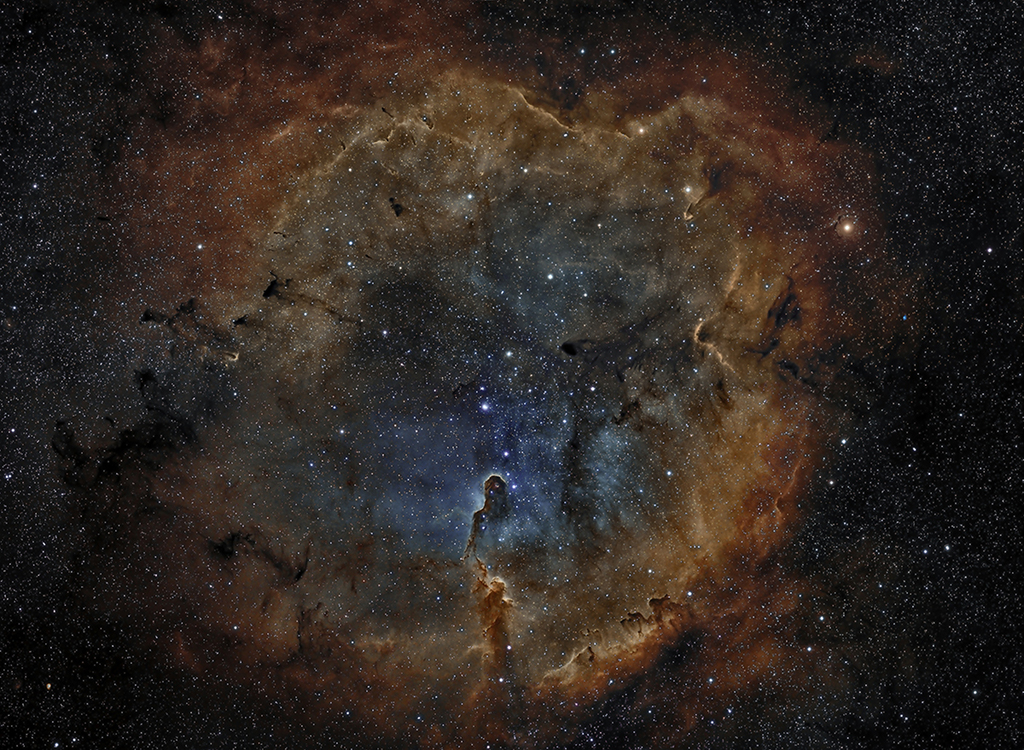
Stunning emission nebula IC 1396 mixes glowing cosmic gas and dark dust clouds in the high and far off constellation of Cepheus. Energized by the bright central star seen here, this star forming region sprawls across hundreds of light-years, spanning over three degrees on the sky while nearly 3,000 light-years from planet Earth. Among the intriguing dark shapes within IC 1396, the winding Elephant's Trunk nebula lies just below center. Stars could still be forming inside the dark shapes by gravitational collapse. But as the denser clouds are eroded away by powerful stellar winds and radiation, any forming stars will ultimately be cutoff from the reservoir of star stuff. The gorgeous color view is a composition of image data from narrowband filters, mapping emission from the nebula's atomic oxygen, hydrogen, and sulfur into blue, green, and red hues. via NASA http://ift.tt/2vgKUex
Final: Giants 5 Indians 4. WP: SF C Gearrin (4-3) LP: CLE B Shaw (2-4) (ESPN)
from ESPN http://ift.tt/1dPqUAn
July 14 Solar Flare and a Coronal Mass Ejection

A medium-sized (M2) solar flare and a coronal mass ejection erupted from the same, large active region of the sun on July 14, 2017. The flare lasted almost two hours, quite a long duration. The coils arcing over this active region are particles spiraling along magnetic field lines. via NASA http://ift.tt/2uJ7lf4
F/10: Giants 2 Indians 1. WP: SF S Dyson (2-7) LP: CLE C Allen (0-5) (ESPN)
from ESPN http://ift.tt/1dPqUAn
Ireson Hill on Mars
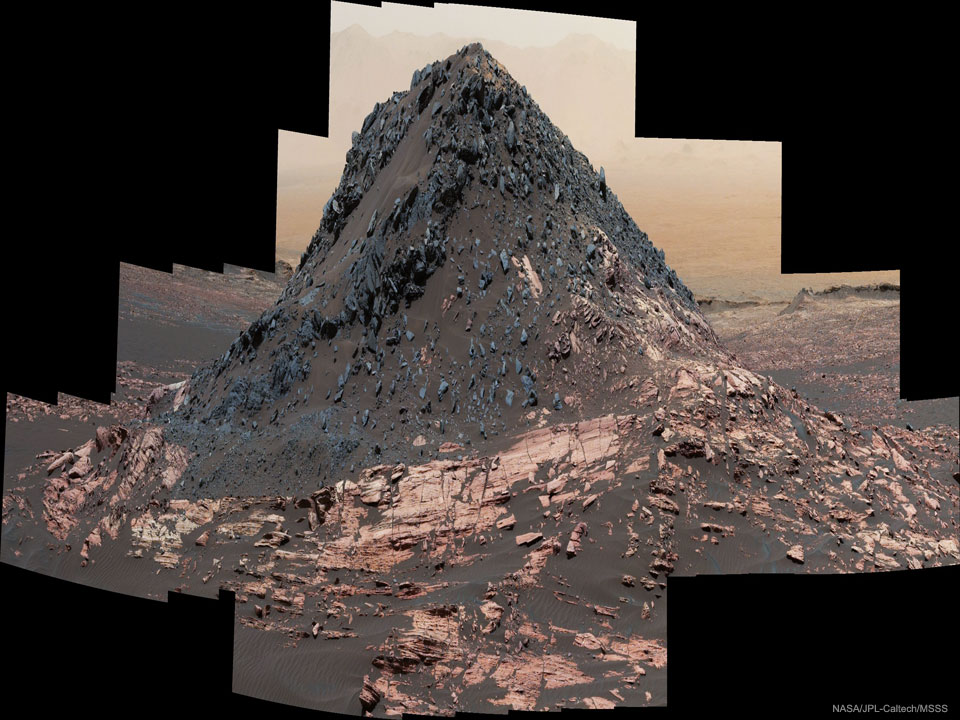
What created this unusual hill on Mars? Its history has become a topic of research, but its shape and two-tone structure makes it one of the more unusual hills that the robotic Curiosity rover on Mars has rolled near. Dubbed Ireson Hill, the mound rises about 5 meters high and spans about 15 meters across. Ireson Hill is located on the Bagnold Dune field on the slope of Mount Sharp in Gale Crater on Mars. The featured 41-image panorama has been horizontally compressed to include the entire hill. The image was taken on February 2 and released last week. Because Mars is moving behind the Sun as seen from the Earth, NASA will soon stop sending commands to its Martian orbiters and rovers until about August 1. via NASA http://ift.tt/2uCRIpD
NASA Evaluates How Crew Will Exit Orion Spacecraft

When astronauts return to Earth from destinations beyond the moon in NASA’s Orion spacecraft and splashdown in the Pacific Ocean, they’ll still need to safely get out of the spacecraft and back on dry land. Using the waters off the coast of Galveston, a NASA and Department of Defense team tested Orion exit procedures on July 10-14, 2017. via NASA http://ift.tt/2vefiGn
Thunder Moon over Pisa
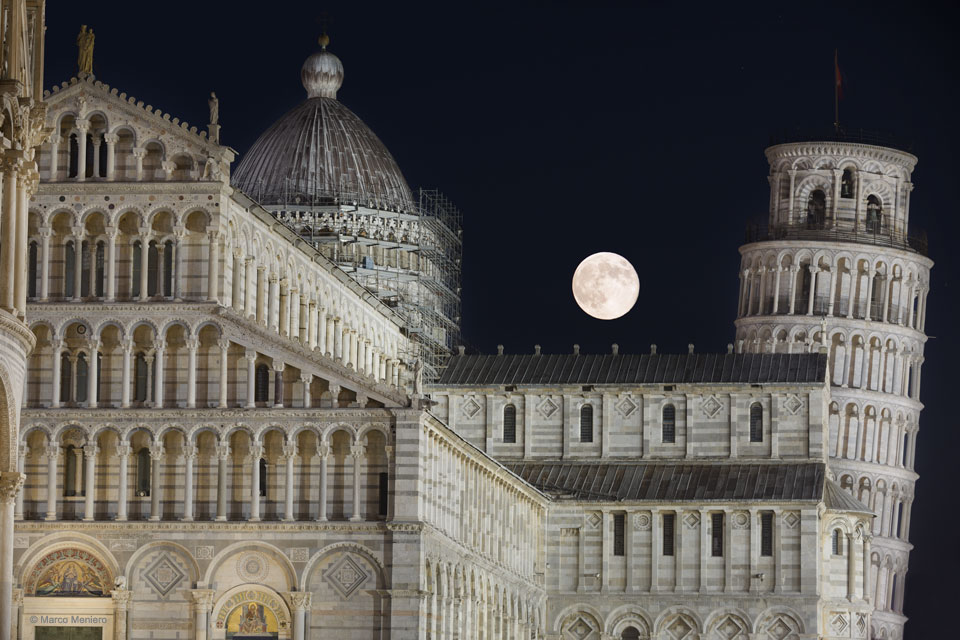
What's wrong with this picture? If you figure it out, you may then realize where the image was taken. The oddity lies actually in one of the buildings -- it leans. The Leaning Tower of Pisa has been an iconic legend since shortly after its construction began in the year 1173. Now part of a UNESCO World Heritage Site, folklore holds that Galileo used the leaning tower to dramatically demonstrate the gravitational principle that objects of different mass fall the same. Between the Leaning Tower of Pisa on the right and Pisa Cathedral and the Pisa Baptistery on the left, a full "Thunder" moon was visible last week when the image was taken. Using modern analyses, the tower has been successfully stabilized and, barring the unexpected, should hold its present tilt for the next 200 years. via NASA http://ift.tt/2vtTvJQ
NASA Langley and the Space Race

Neil Armstrong trained for the Apollo 11 mission at NASA Langley's Lunar Landing Research Facility on equipment that cancelled all but one-sixth of Earth's gravitational force. Armstrong offered perhaps the greatest tribute to the importance of his training when asked what it was like to land on the moon, replying, "Like Langley." via NASA http://ift.tt/2tjeylH
Final: Padres 7 Giants 1. WP: SD T Cahill (4-3) LP: SF J Samardzija (4-11) (ESPN)
from ESPN http://ift.tt/1dPqUAn
Lightning Eclipse from the Planet of the Goats
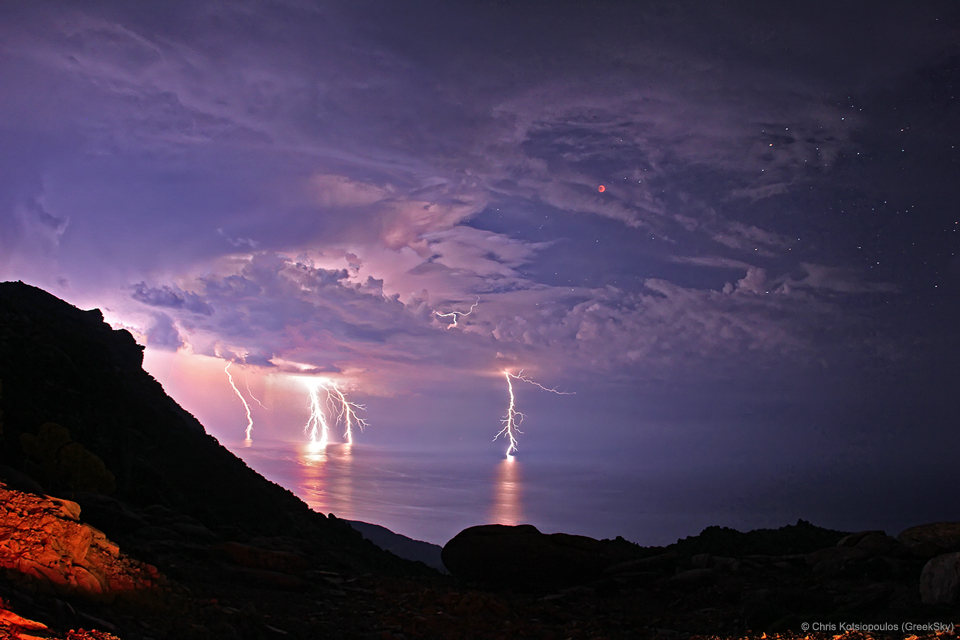
Thunderstorms almost spoiled this view of the spectacular 2011 June 15 total lunar eclipse. Instead, storm clouds parted for 10 minutes during the total eclipse phase and lightning bolts contributed to the dramatic sky. Captured with a 30-second exposure the scene also inspired one of the more memorable titles (thanks to the astrophotographer) in APOD's now 22-year history. Of course, the lightning reference clearly makes sense, and the shadow play of the dark lunar eclipse was widely viewed across planet Earth in Europe, Africa, Asia, and Australia. The picture itself, however, was shot from the Greek island of Ikaria at Pezi. That area is known as "the planet of the goats" because of the rough terrain and strange looking rocks. via NASA http://ift.tt/2vnh0Eo
Final: Padres 5 Giants 3. WP: SD B Maurer (1-4) LP: SF C Gearrin (3-3) (ESPN)
from ESPN http://ift.tt/1dPqUAn
Giants must take wrecking ball to lineup at trade deadline - Joe Peta (ESPN)
from ESPN http://ift.tt/1dPqUAn
Giants activate 3B Eduardo Nunez (strained hamstring) from 10-day DL (ESPN)
from ESPN http://ift.tt/1dPqUAn
Hubble Traps a Lynx Barred Spiral

NGC 2500 is a particular kind of spiral galaxy known as a barred spiral, its wispy arms swirling out from a bright, elongated core. via NASA http://ift.tt/2tU0IDG
NGC 4449: Close up of a Small Galaxy
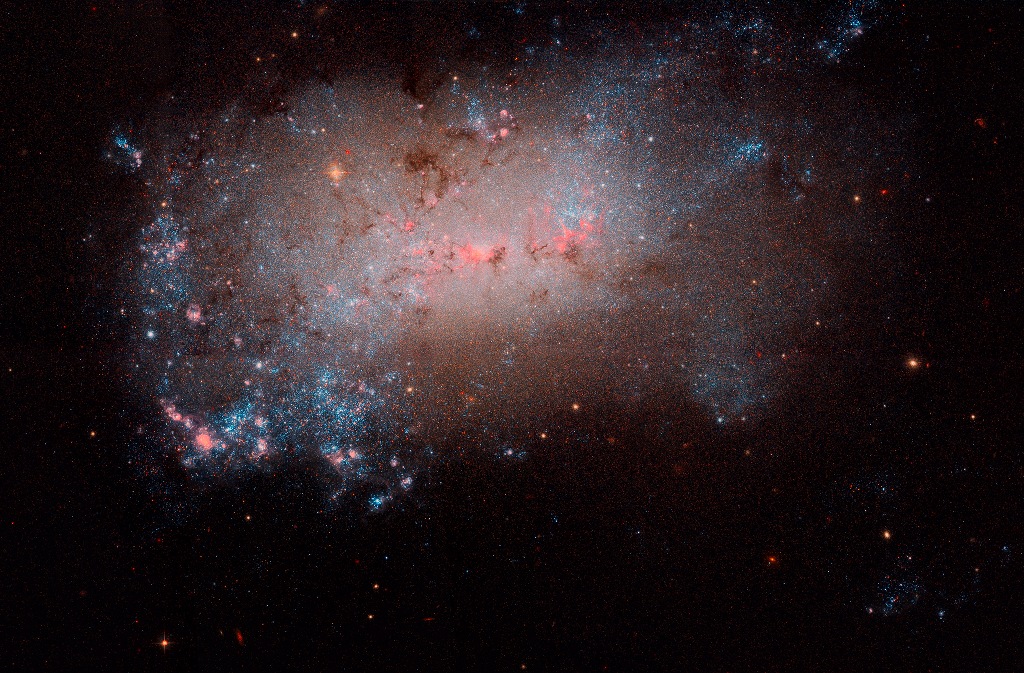
(xxxedit and linkxxx) Grand spiral galaxies often seem to get all the glory. Their young, blue star clusters and pink star forming regions along sweeping spiral arms are guaranteed to attract attention. But small irregular galaxies form stars too, like NGC 4449, about 12 million light-years distant. Less than 20,000 light-years across, the small island universe is similar in size, and often compared to our Milky Way's satellite galaxy, the Large Magellanic Cloud (LMC). This remarkable Hubble Space Telescope close-up of the well-studied galaxy was reprocessed to highlight the telltale reddish glow of hydrogen gas. The glow traces NGC 4449's widespread star forming regions, some even larger than those in the LMC, with enormous interstellar arcs and bubbles blown by short-lived, massive stars. NGC 4449 is a member of a group of galaxies found in the constellation Canes Venatici. It also holds the distinction of being the first dwarf galaxy with an identified tidal star stream. via NASA http://ift.tt/2ugs7Sm
Jupiter’s Great Red Spot (Enhanced Color)

This enhanced-color image of Jupiter’s Great Red Spot was created by citizen scientist Gerald Eichstädt using data from the JunoCam imager on NASA’s Juno spacecraft. via NASA http://ift.tt/2tQeNll
Full Moon and Boston Light
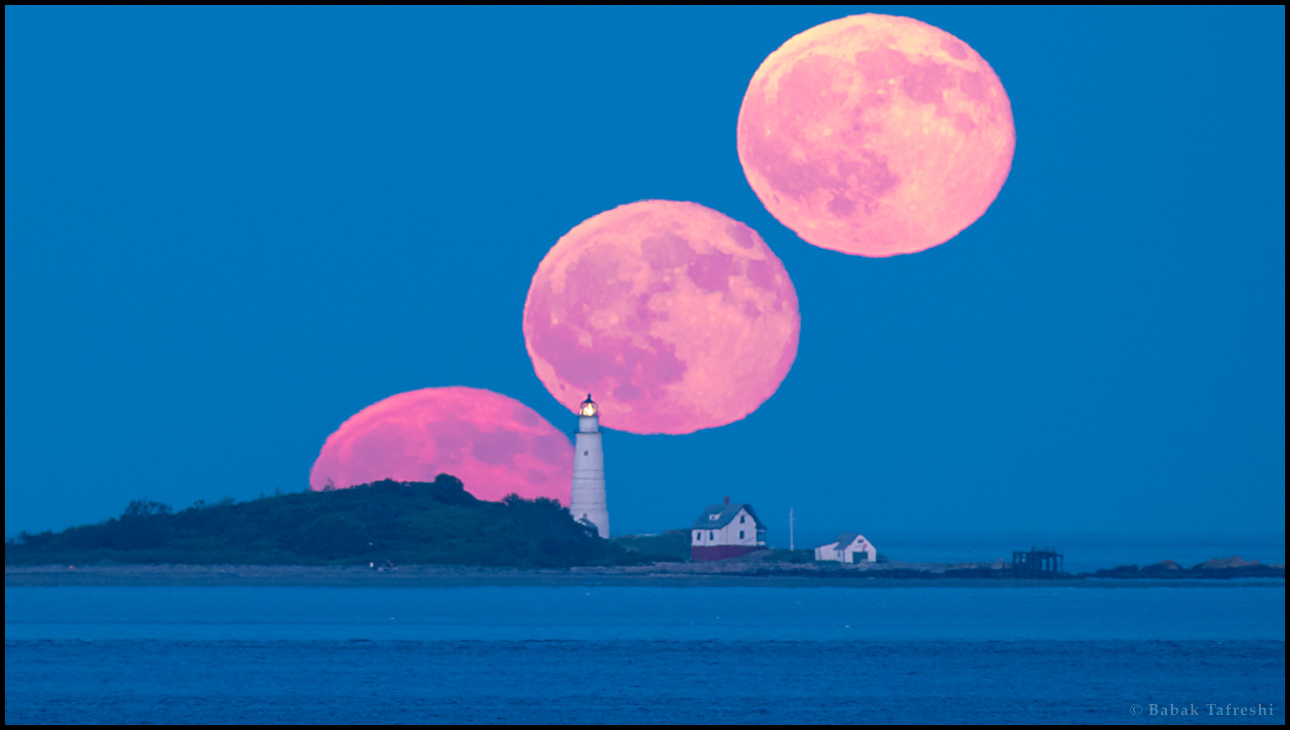
This well-planned telephoto timelapse captures July's Full Moon rise across outer Boston Harbor, Massachusetts, planet Earth. In the foreground, the historic terrestrial beacon is known as Boston Light. July's Full Moon is known to some as a Thunder Moon, likely a reference to the sounds of the northern summer month's typically stormy weather. But the eastern sky was clear for this video sequence. Near the horizon, the long sight-line through atmospheric layers filters and refracts the moonlight, causing the rising Moon's reddened color, ragged edges and distorted shape. via NASA http://ift.tt/2t2FdmP
Looking Back: Aircraft Engineering Research Conference at Langley's Full Scale Tunnel, 1934

This year, NASA is celebrating the 100th anniversary of the agency’s Langley Research Center in Hampton, Virginia. In Langley's early years of crafting flight, aviation pioneers flocked to the center for engineering conferences. This photo was taken in Langley's Full Scale Tunnel during the 1934 Aircraft Engineering Research Conference. via NASA http://ift.tt/2sQ4IDO
Messier 63: The Sunflower Galaxy
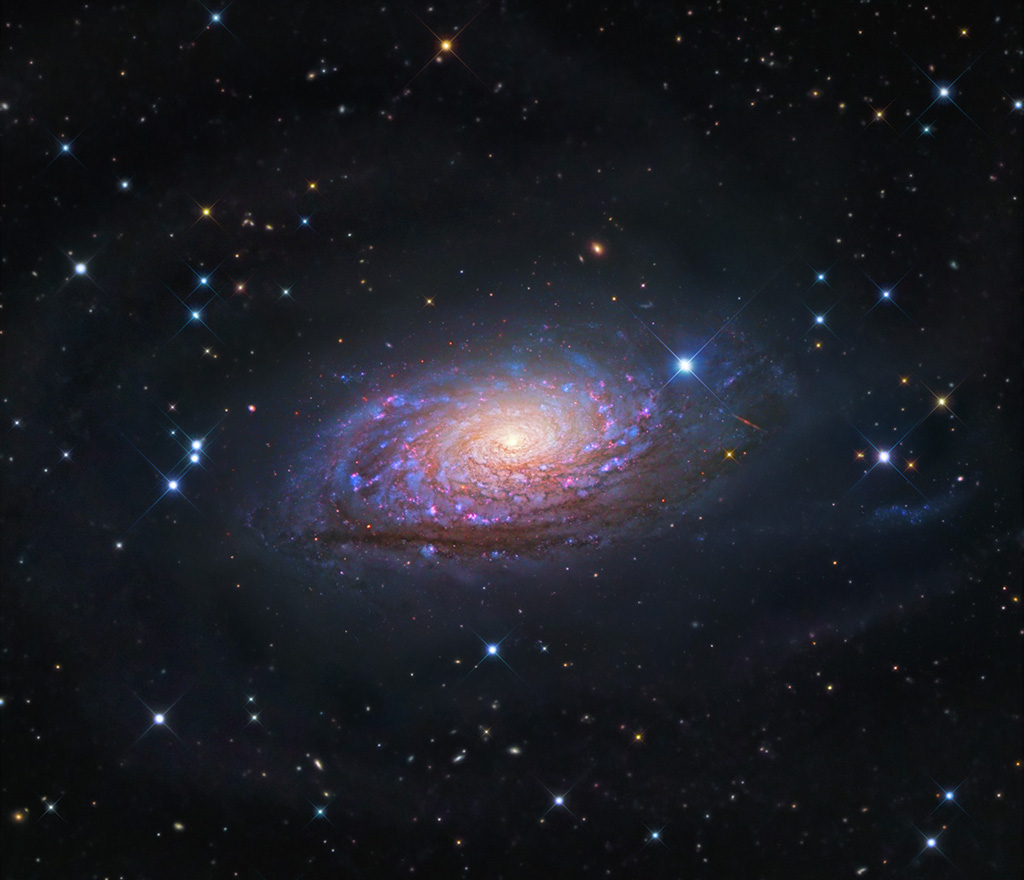
A bright spiral galaxy of the northern sky, Messier 63 is about 25 million light-years distant in the loyal constellation Canes Venatici. Also cataloged as NGC 5055, the majestic island universe is nearly 100,000 light-years across. That's about the size of our own Milky Way Galaxy. Known by the popular moniker, The Sunflower Galaxy, M63 sports a bright yellowish core in this sharp composite image from space- and ground-based telescopes. Its sweeping blue spiral arms are streaked with cosmic dust lanes and dotted with pink star forming regions. A dominant member of a known galaxy group, M63 has faint, extended features that are likely star streams from tidally disrupted satellite galaxies. M63 shines across the electromagnetic spectrum and is thought to have undergone bursts of intense star formation. via NASA http://ift.tt/2v5Wecs
Lakes and Rivers Have Ice, Too

On May 29, 2017, the Moderate Resolution Imaging Spectroradiometer (MODIS) on NASA’s Terra satellite captured this image of ice covering the Amundsen Gulf, Great Bear Lake, and numerous small lakes in the northern reaches of Canada’s Northwest Territories and Nunavut. Icy lakes and rivers make a significant footprint on the Arctic landscape. via NASA http://ift.tt/2tJZ0om
Star Cluster Omega Centauri in HDR
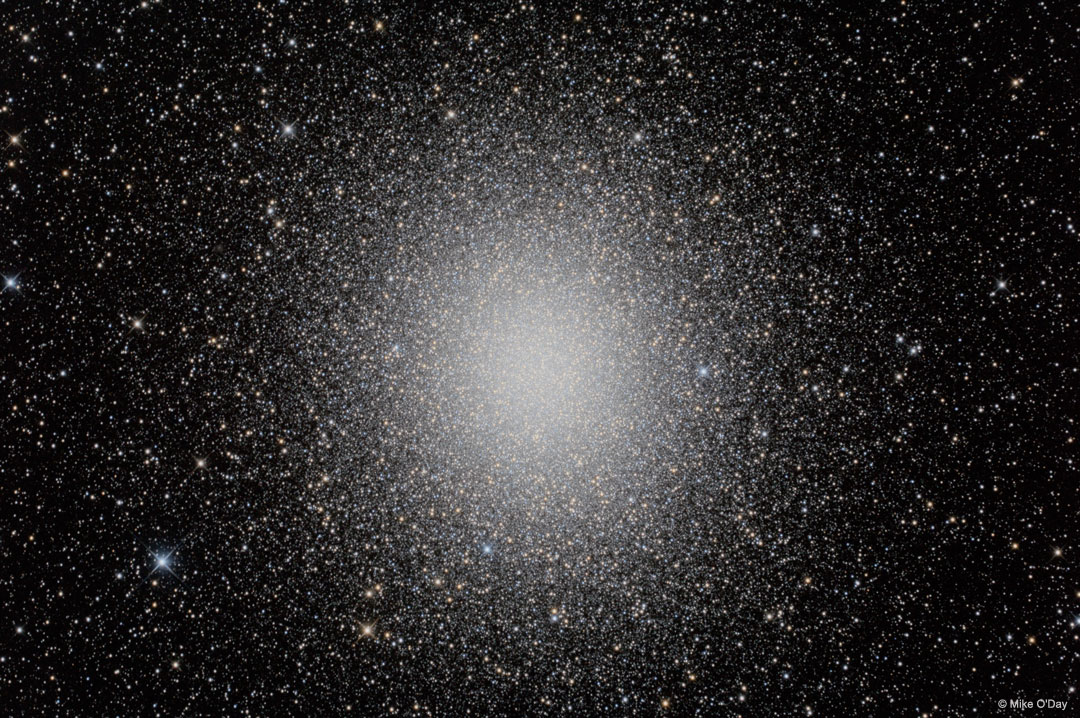
Behold the largest ball of stars in our galaxy. Omega Centauri is packed with about 10 million stars, many older than our Sun and packed within a volume of only about 150 light-years in diameter. The star cluster is the largest and brightest of 200 or so known globular clusters that roam the halo of our Milky Way galaxy. Though most star clusters consist of stars with the same age and composition, the enigmatic Omega Cen exhibits the presence of different stellar populations with a spread of ages and chemical abundances. In fact, Omega Cen may be the remnant core of a small galaxy merging with the Milky Way. The featured image shows so many stars because it merged different exposures with high dynamic range (HDR) techniques. Omega Centauri, also known as NGC 5139, lies about 15,000 light-years away toward the southern constellation of the Centaurus. via NASA http://ift.tt/2tFFKIl
Dawn’s Early Light

The light of a new day on Saturn illuminates the planet’s wavy cloud patterns and the smooth arcs of the vast rings. via NASA http://ift.tt/2sWYfeq
Spiral Galaxy NGC 1512: The Nuclear Ring
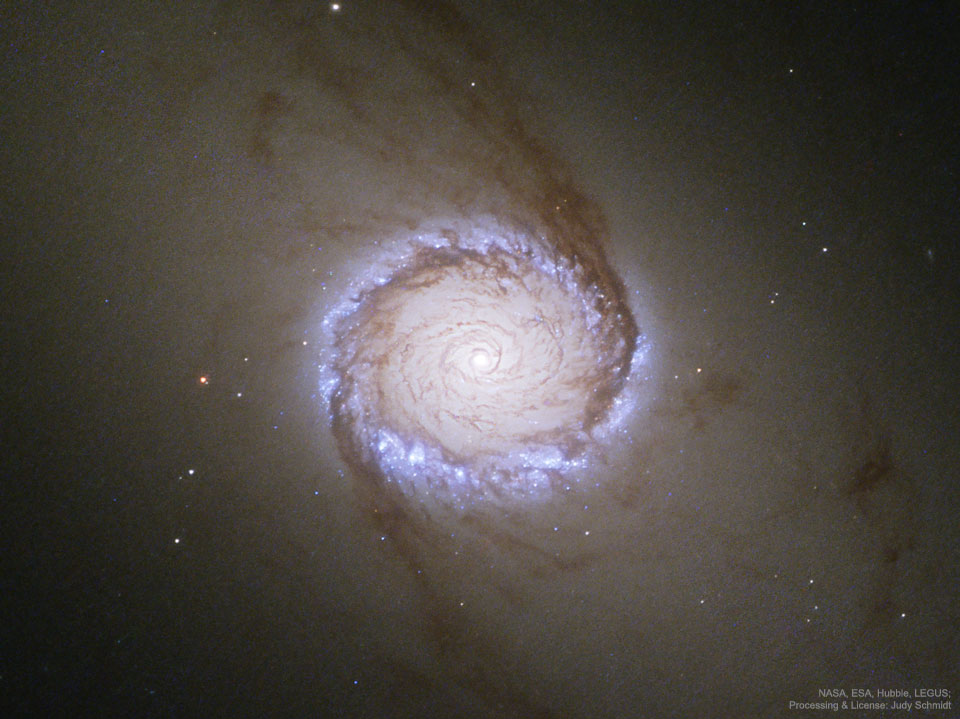
What's happening around the center of this spiral galaxy? Seen in total, NGC 1512 appears to be a barred spiral galaxy -- a type of spiral that has a straight bar of stars across its center. This bar crosses an outer ring, though, a ring not seen as it surrounds the pictured region. Featured in this Hubble Space Telescope image is an inner ring -- one that itself surrounds the nucleus of the spiral. The two rings are connected not only by a bar of bright stars but by dark lanes of dust. Inside of this inner ring, dust continues to spiral right into the very center -- possibly the location of a large black hole. The rings are bright with newly formed stars which may have been triggered by the collision of NGC 1512 with its galactic neighbor, NGC 1510. via NASA http://ift.tt/2tVECTF
Earth at Night

Can you find your favorite country or city? Surprisingly, on this world-wide nightscape, city lights make this task quite possible. Human-made lights highlight particularly developed or populated areas of the Earth's surface, including the seaboards of Europe, the eastern United States, and Japan. Many large cities are located near rivers or oceans so that they can exchange goods cheaply by boat. Particularly dark areas include the central parts of South America, Africa, Asia, and Australia. The featured composite was created from images that were collected during cloud-free periods in April and October 2012 by the Suomi-NPP satellite, from a polar orbit about 824 kilometers above the surface, using its Visible Infrared Imaging Radiometer Suite (VIIRS). via NASA http://ift.tt/2sX5LkD
Final: Marlins 6 Giants 1. WP: MIA D Straily (7-4) LP: SF M Moore (3-9) (ESPN)
from ESPN http://ift.tt/1dPqUAn
Hidden Galaxy IC 342
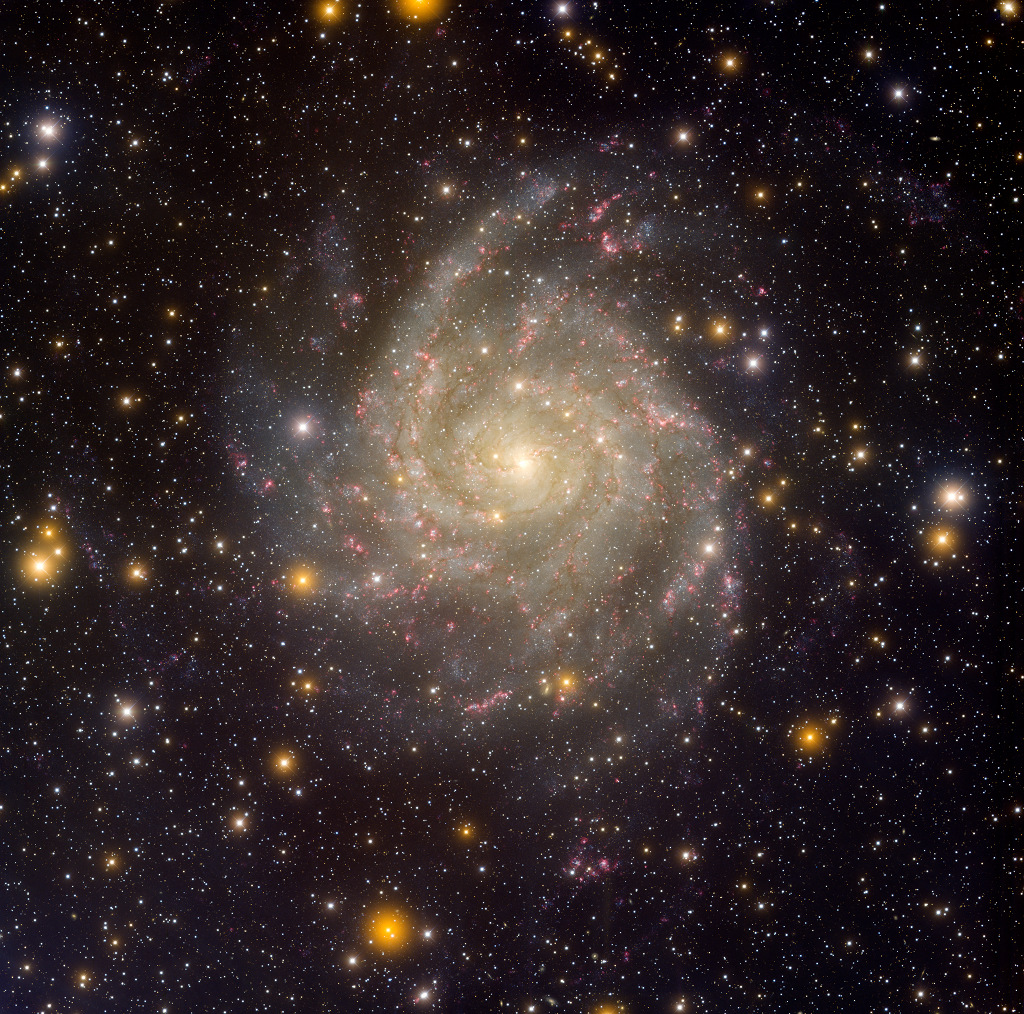
Similar in size to large, bright spiral galaxies in our neighborhood, IC 342 is a mere 10 million light-years distant in the long-necked, northern constellation Camelopardalis. A sprawling island universe, IC 342 would otherwise be a prominent galaxy in our night sky, but it is hidden from clear view and only glimpsed through the veil of stars, gas and dust clouds along the plane of our own Milky Way galaxy. Even though IC 342's light is dimmed by intervening cosmic clouds, this sharp telescopic image traces the galaxy's own obscuring dust, blue star clusters, and glowing pink star forming regions along spiral arms that wind far from the galaxy's core. IC 342 may have undergone a recent burst of star formation activity and is close enough to have gravitationally influenced the evolution of the local group of galaxies and the Milky Way. via NASA http://ift.tt/2uwQnx4
Winds Trigger Pond Growth

Wind is a force to be reckoned with. It can stir up monsoons, carry dust thousands of miles, and sculpt rock into sinuous arches. But sometimes, the effects of wind go unnoticed for years, like when it carves away slowly at the edges of a pond. via NASA http://ift.tt/2suFpH8
A View Toward M106
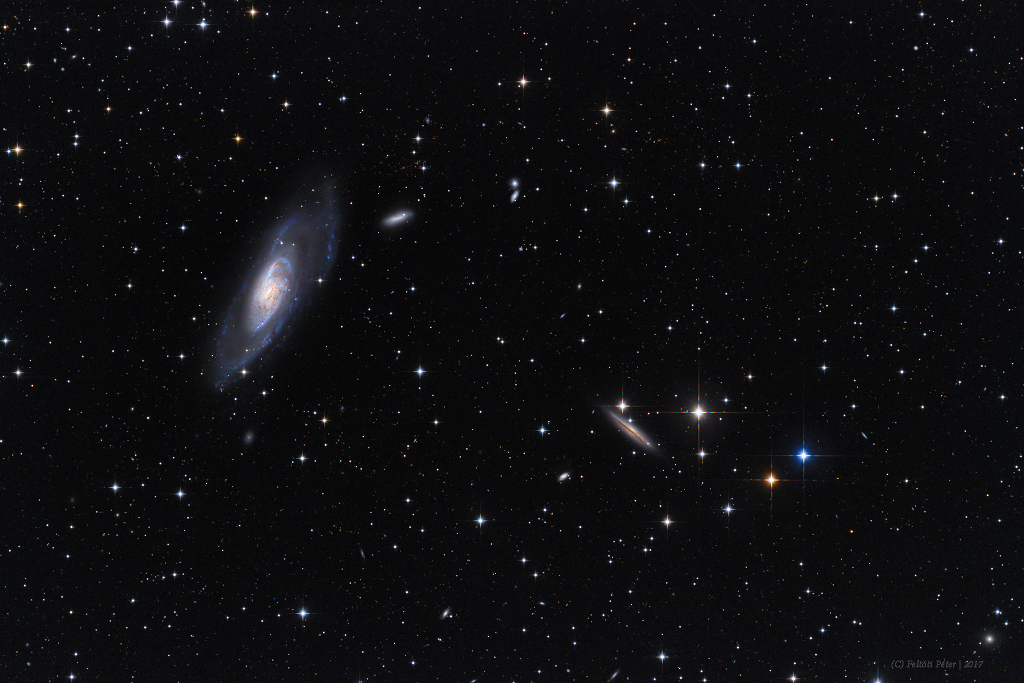
Big, bright, beautiful spiral, Messier 106 dominates this cosmic vista. The two degree wide telescopic field of view looks toward the well-trained constellation Canes Venatici, near the handle of the Big Dipper. Also known as NGC 4258, M106 is about 80,000 light-years across and 23.5 million light-years away, the largest member of the Canes II galaxy group. For a far away galaxy, the distance to M106 is well-known in part because it can be directly measured by tracking this galaxy's remarkable maser, or microwave laser emission. Very rare but naturally occuring, the maser emission is produced by water molecules in molecular clouds orbiting its active galactic nucleus. Another prominent spiral galaxy on the scene, viewed nearly edge-on, is NGC 4217 below and right of M106. The distance to NGC 4217 is much less well-known, estimated to be about 60 million light-years. via NASA http://ift.tt/2tKWlNp
Vice President Mike Pence Visits Kennedy Space Center

Vice President Mike Pence addresses NASA employees, Thursday, July 6, 2017, at the Vehicle Assembly Building at NASA’s Kennedy Space Center (KSC) in Cape Canaveral, Florida. via NASA http://ift.tt/2sRRqpn
Final: Tigers 6 Giants 2. WP: DET A Sanchez (1-0) LP: SF C Stratton (0-2) (ESPN)
from ESPN http://ift.tt/1dPqUAn
This Week in NASA History: Apollo AS-203 Launches -- July 5, 1966

This week in 1966, the AS-203 rocket launched from NASA’s Kennedy Space Center. The Apollo AS-203 mission was an uncrewed test of the vehicle’s second stage, the S-IVB stage, and the instrument unit of the Saturn V to obtain flight information under orbital conditions. via NASA http://ift.tt/2sFZqP6
Aphelion Sunrise
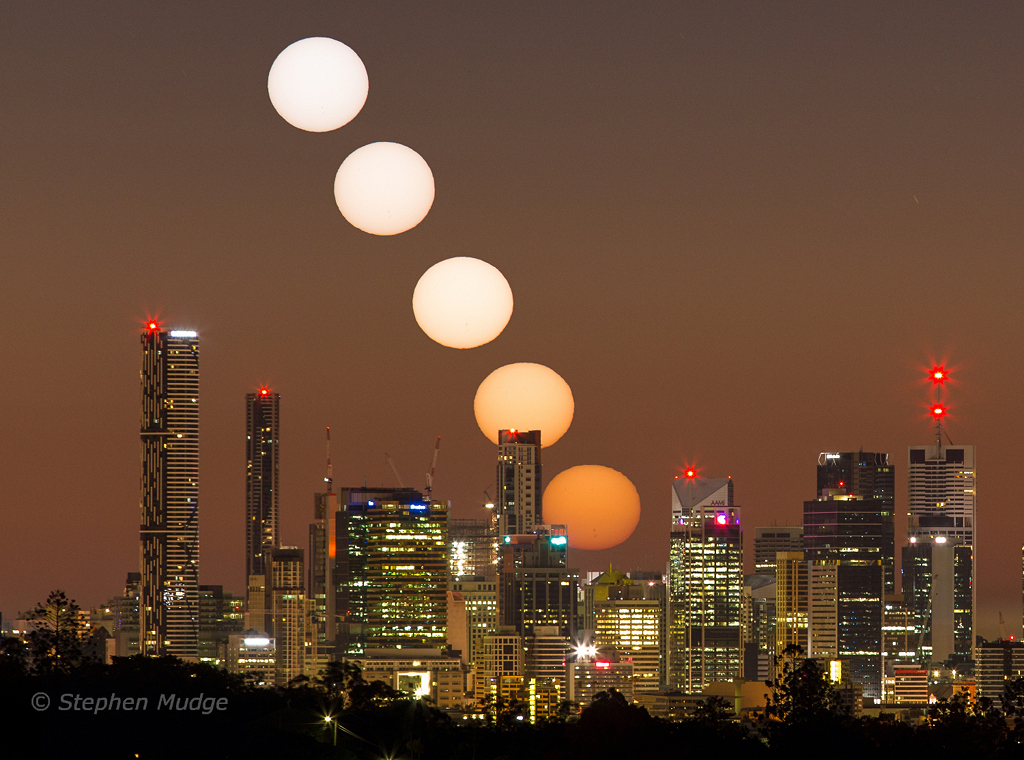
On July 3rd, planet Earth reached aphelion, the farthest point in its elliptical orbit around the Sun. Each year, this day of the most distant Sun happens to occur during winter in the southern hemisphere. That's where this aphelion sunrise from 2015 was captured in a time series composite against the skyline of Brisbane, Australia. Of course, seasons for our fair planet are not determined by distance to the Sun, but by the tilt of Earth's rotational axis with respect to the ecliptic, the plane of its orbit. Fondly known as the obliquity of the ecliptic, the angle of the tilt is about 23.4 degrees from perpendicular to the orbital plane. So the most distant sunrise occurs during northern summer, when the planet's north pole is tilted toward the Sun and the north enjoys longer, warmer days. via NASA http://ift.tt/2ulvNQp
Final: Tigers 5 Giants 3. WP: DET M Fulmer (8-6) LP: SF M Cain (3-8) (ESPN)
from ESPN http://ift.tt/1dPqUAn
Happy Fourth of July From the Space Station

NASA astronauts Jack Fischer and Peggy Whitson celebrated the Fourth of July from over 250 miles above Earth on the International Space Station. Fischer shared this photo on social media and said, "We sometimes have issues standing up straight, but we have no problems at all showing our American pride-Happy 4th!" via NASA http://ift.tt/2umrzrV
Dragon Returns Space Station Science to Earth

NASA astronaut Jack Fischer photographed the SpaceX Dragon capsule as it reentered Earth's atmosphere before splashing down in the Pacific Ocean west of Baja California at 8:12 a.m. EDT, July 3, 2017. Fischer commented, "Beautiful expanse of stars-but the “long” orange one is SpaceX-11 reentering!" via NASA http://ift.tt/2t9KQy8
The Summer Triangle over the Great Wall
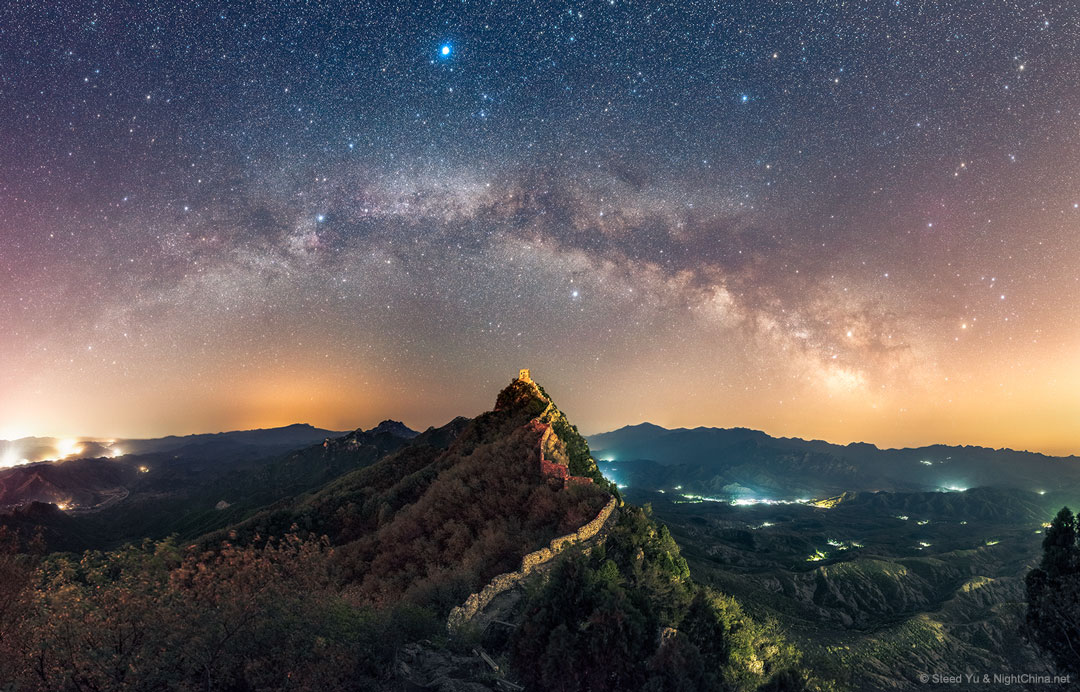
Have you ever seen the Summer Triangle? The bright stars Vega, Deneb, and Altair form a large triangle on the sky that can be seen rising in the northern spring during the morning, and rising in the northern fall during the evening. During summer months, the triangle can be found nearly overhead near midnight as three of the brightest stars on the sky. Featured here, along with the arch of the central band of our Milky Way Galaxy, the Summer Triangle asterism was captured this spring over the Great Wall of China. This part of the Great Wall, a World Culture Heritage Site, was built during the 6th century on the Yan Mountains. At the summit is Wangjinglou Tower from which, on a clear night, the lights of Beijing are visible in the distance. via NASA http://ift.tt/2udOcP0
Mountains of Dust in the Carina Nebula

It's stars versus dust in the Carina Nebula and the stars are winning. More precisely, the energetic light and winds from massive newly formed stars are evaporating and dispersing the dusty stellar nurseries in which they formed. Located in the Carina Nebula and known informally as Mystic Mountain, these pillar's appearance is dominated by the dark dust even though it is composed mostly of clear hydrogen gas. Dust pillars such as these are actually much thinner than air and only appear as mountains due to relatively small amounts of opaque interstellar dust. About 7,500 light-years distant, the featured image was taken with the Hubble Space Telescope and highlights an interior region of Carina which spans about three light years. Within a few million years, the stars will likely win out completely and the entire dust mountain will evaporate. via NASA http://ift.tt/2uvhGqS
Giants recall P Chris Stratton from Triple-A Sacramento; option RHP Dan Slania (ESPN)
from ESPN http://ift.tt/1dPqUAn
Subscribe to:
Posts (Atom)